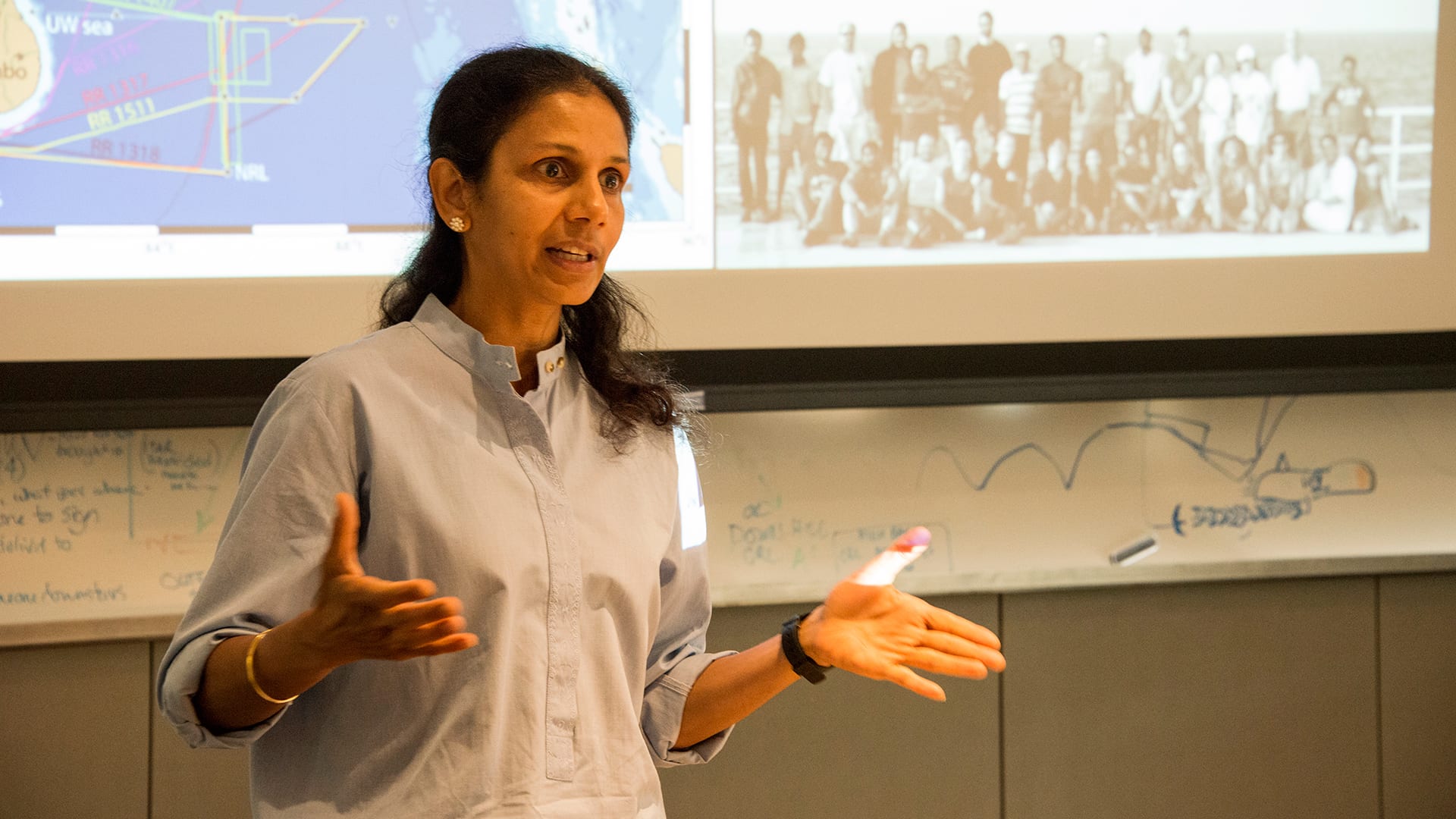5 Questions with Dr. Amala Mahadevan
WHOI physical oceanographer sheds light on the climate-critical link between currents and plankton
By Evan Lubofsky | October 21, 2020

Dr. Amala Mahadevan is a physical oceanographer at Woods Hole Oceanographic Institution. She and her team rely on a combination of simulated ocean models and observational data to investigate the impacts of physical oceanographic processes on phytoplankton—the microscopic plants that use sunlight and carbon dioxide to grow and reproduce at the ocean’s surface. Here, she discusses some of the challenges in understanding links between ocean physics and plankton biology.
1. Oceanus: The term plankton comes from the Greek word for “wander” or “drift” which seems appropriate given how they are moved about by the ocean. What role do currents play in the survival of these tiny, meandering creatures?
Mahadevan: Ocean currents—particularly, swirling currents known as eddies—can affect plankton in two primary ways. First, they can contribute to their growth by bringing up nutrients from ocean depths to the surface. These primarily include nitrate, phosphate and in some places where dust is scarce, small amounts of iron. These nutrients, which plankton need to grow and reproduce, are typically very abundant in deeper layers of the ocean, but in the upper ocean they’re scarce. At the same time, eddies can inhibit plankton growth by pushing them down into deeper, darker waters where there’s no sunlight for growth to occur. So, there’s this counter-play between the physics and the biology that we’re trying to better understand.
2. Oceanus: Since phytoplankton help take heat-trapping carbon dioxide out of the atmosphere to grow, it would seem that the deeper these organisms are pushed down, the better it is for our climate?
Mahadevan: Taking dissolved carbon from the surface layer and transporting it to deeper layers of the ocean causes some of the carbon to become sequestered. And the deeper the carbon goes, the longer it stays out of the atmosphere. What’s interesting is that the organic carbon particles range widely in terms of size—from microns to millimeters. The larger particles are often heavy enough to sink to depth on their own, but the smaller particles don’t tend to get down that far. So, the downward motion of the eddies is one of the transport mechanisms. And the currents can push plankton cells down pretty deep, to a few hundred meters below the surface mixed layer, and even as deep as 1,000 meters in some cases. Knowing this helps us understand more about the rate of the ocean’s biological pump—specifically, how much of the particulate organic carbon in the sunlit layer gets sequestered deep in the ocean, where it can remain for very long periods of time.
3. Oceanus: You use three-dimensional computer models in your work. Why 3D, and how is the technology helping you better understand these processes?
Mahadevan: Ocean eddies swirl seawater horizontally over scales of 10—100 kilometers in a few days, but typically only 10-100s of meters vertically in the same amount of time. To model the vertical motion of these currents, we necessarily need to consider their dynamics as they move horizontally. Looking at currents just one way and not the other does not give us a full picture of the water’s motion or the dynamics that generates the transport.
4. Oceanus: According to a review paper in Science last year, our oceans are warming faster than previously thought—potentially 40 percent faster than earlier estimates. How is this warming trend affecting plankton communities?
Mahadevan: For plankton, there is clearly a biological response to ocean warming. As the ocean warms, it can create a stronger difference of density between the surface and subsurface. This inhibits vertical mixing and communication between the mixed layer near the surface, and deeper layers of the ocean. This, in turn, can decrease the amount of upward mixing of nutrients into the surface ocean. A change in the physical supply rate of nutrients could change the types and sizes of phytoplankton we see in the future, which has implications for the rest of the oceanic ecosystem and the biological pump.
At higher latitudes, warmer ocean temperatures and increased exposure to light could enhance the growth rate of phytoplankton during the winter months. But, spring is a critical season and supports large phytoplankton blooms. So, a more rapid winter-to-summer seasonal transition could alter the spring bloom, a time of prolific biological productivity in regions such as the sub-polar North Atlantic.
5. Oceanus: Given so many variables—warming ocean temperatures, the mixing of shallow and deeper waters, the availability of nutrients and sunlight, etc.—establishing the relationship between ocean physics and plankton biology seems incredibly complex. Moving forward, where do you see this research headed?
Mahadevan: The connections we’re just starting to understand have a long way to go. We’ve only scratched the surface as to what the biological implications are, because of the immense diversity of organisms. Part of the issue is that there has been no baseline for what the biological community structures of plankton were in the past. So, we need to conduct more studies to try to understand how the oceanic ecosystem is responding to the changing physical system, and how the phytoplankton and zooplankton community structure feeds back into the longer-term connection to climate.
